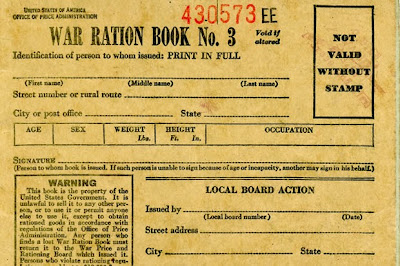Many of our parents and grandparents had to use the government issued "food coupons!" Let's hope that something like this never happens again, and strive to assure that it doesn't! Want to see what a typical coupon looked like? Here ya go!
World War II
Soon after the Japanese attack on Pearl Harbor and America’s subsequent entrance into World War II, it became apparent that voluntary conservation on the home front was not going to suffice this time around. Restrictions on imported foods, limitations on the transportation of goods due to a shortage of rubber tires, and a diversion of agricultural harvests to soldiers overseas all contributed to the U.S. government’s decision to ration certain essential items. On January 30, 1942, the Emergency Price Control Act granted the Office of Price Administration (OPA) the authority to set price limits and ration food and other commodities in order to discourage hoarding and ensure the equitable distribution of scarce resources. By the spring, Americans were unable to purchase sugar without government-issued food coupons. Vouchers for coffee were introduced in November, and by March of 1943, meat, cheese, fats, canned fish, canned milk and other processed foods were added to the list of rationed provisions.
Every American was entitled to a series of war ration books filled with stamps that could be used to buy restricted items (along with payment), and within weeks of the first issuance, more than 91 percent of the U.S. population had registered to receive them. The OPA allotted a certain amount of points to each food item based on its availability, and customers were allowed to use 48 ‘blue points’ to buy canned, bottled or dried foods, and 64 ‘red points’ to buy meat, fish and dairy each month—that is, if the items were in stock at the market. Due to changes in the supply and demand of various goods, the OPA periodically adjusted point values, which often further complicated an already complex system that required home cooks to plan well in advance to prepare meals.
Despite the fact that ration books were explicitly intended for the sole use by the named recipient, a barter system developed whereby people traded one type of stamp for another, and black markets began cropping up all over the country in which forged ration stamps or stolen items were illegally resold. By the end of the war, restrictions on processed foods and other goods like gasoline and fuel oil were lifted, but the rationing of sugar remained in effect until 1947.
This is just part of a larger explanation of some of the shortages the U.S. faced during the war. You can read more of the article here! Scary stuff, if you ask me! I don't want to ever experience anything like that. Know what I mean?
Coffee out on the patio this morning. Don't worry...I have plenty!

gas rationing was contemplated in the 70s. They even printed the coupons but never used them. Huge waste of money.
ReplyDeleteI still have my ration book from the war - I was only a baby, but I had one too! (A lot of tickets were used, though!) Glad you have plenty of coffee - I'll bring some Dunkins!
ReplyDeleteI have some books and coupons from WWII that were my grandparent's.
ReplyDeleteI remember those day and The one thing I remember well that (Spam) was not rationed
ReplyDeleteI was just trying to explain this to one of my grand kids the other day when he brought up a story about my dad (his great granddad) Now I can tell him where to find this story. Thank you
ReplyDeleteI'll see you all at the patio
There were some of those rationing coupon books in with my Mother's things.
ReplyDeleteHey Sixbears...
ReplyDeleteThat's something the PTB can do with no trouble...waste money!
Thanks for coming over this morning!
Hey Phyllis...
Bet you didn't even remember using them, did ya?
Thanks for coming over today!
Hey Lady Hawthorne...
I would imagine that many of us have some hiding somewhere!
Thanks for coming by today!
Hey Justastick...
Spam was a go-to meat back then! I like it even today!
Thanks for the visit this morning!
Hey Jo...
Always happy to spread a little history around, ya know?
Thanks, sweetie, for coming over today!
Hey Dizzy...
Just a reminder of days gone by and of the trials some folks went through back in those days!
Thanks for dropping in this morning!
My mom often spoke of these times. She was one of eleven kids, and grandma had to be creative to keep everyone fed. Makes you thankful for what we have..I'll meet everyone on the patio :))
ReplyDelete